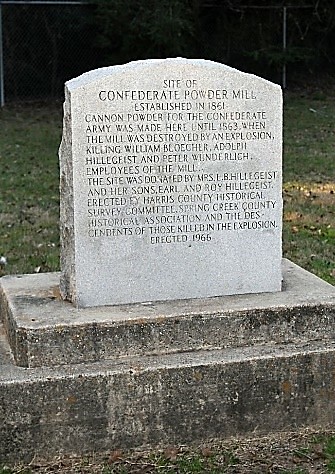The Civil War Touches Northern Harris County - Part 2

As a result of participating as a volunteer soldier in a Civil War battle re-enactment last year at Spring Creek Park in Tomball, I discovered a little local Civil War history. Not many folks know about the Texas Historical Marker that was placed at the out-of-the-way and rarely visited northwest corner of the park in 1966. The Marker was erected to commemorate the site where a mill once made cannon powder for the Confederate army. The mill operated from 1861 until 1864, when a violent explosion leveled the mill and killed multiple employees.
The mill was part of a manufacturing complex on Spring Creek. It included a wagon-building shop, a repair shop, and a blacksmith shop that produced hardware for the cavalry. The complex covered about 4 acres at a site that now includes part of the Powder Mill Estates subdivision in Tomball - adjacent to Spring Creek Park.
Mill workers made black powder by mixing charcoal, sulfur and saltpeter and dissolving the mixture in water. After the water evaporated, the thin cake that was left behind was processed into an explosive powder.
In April 1864, an violent explosion destroyed the mixing room of the mill, totally obliterating all the men who worked in that portion of the mill. While most of the victim’s identities are unknown today, the historical marker does mention three men: William Bloecher, Adolph Hillegeist, and Peter Wunderlich. These three men were working in an area adjacent to the mixing room, and were critically burned. They were taken to the nearby Hillegeist home for care, but Blöcher and Hillegeist died that night, and Wunderlich died the next morning.
The powder mill never reopened. But local people reportedly would still go to the site afterwards to retrieve gunpowder to use to eliminate ant beds. While the historical marker dates the explosion to 1863, church and gravestone records indicate the disaster happened in 1864.
And further, it is very likely that it was not William Bloecher who was burned and died, but rather his father, Johann Jost Blöcher. The German immigrants who built and worked at the powder mill supported the Confederacy, but not necessarily its stance on slavery. By their belief system, the German immigrants were opposed to slavery, but because of religious convictions, they had respect for authority. As a result, they likely supported their local government – which was the Confederate States of America at the time.


